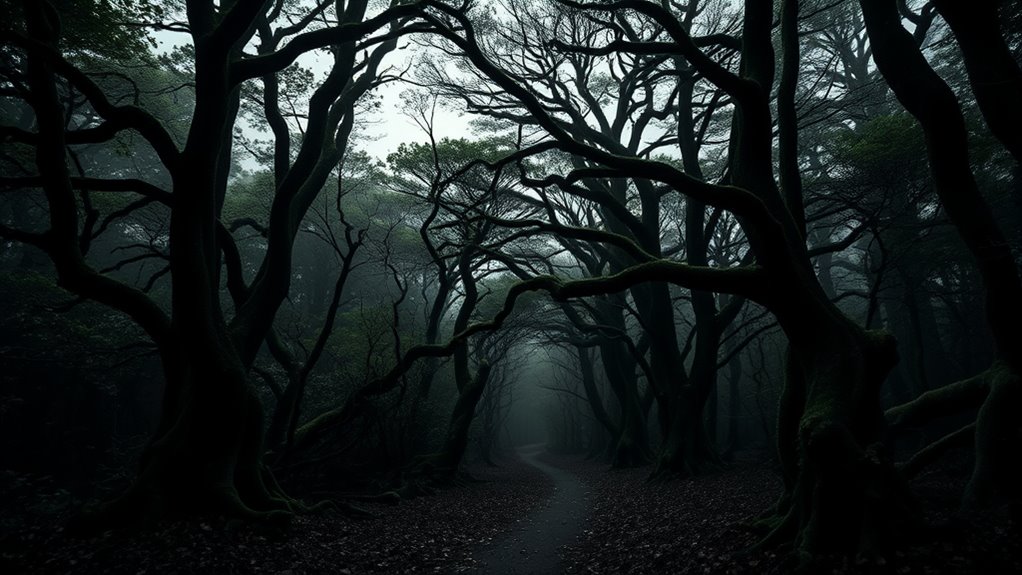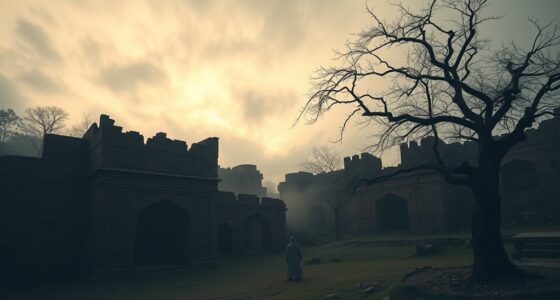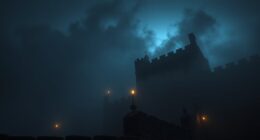Aokigahara Forest, at the base of Mount Fuji, has a long history and is known for its lush scenery, spiritual significance, and eerie reputation. It’s often called Japan’s “Suicide Forest” because of the high number of people who choose to end their lives there each year. Despite its dark fame, the forest also attracts visitors for its natural beauty, wildlife, and cultural importance. If you continue exploring, you’ll uncover more about its history, legends, and efforts to prevent tragedies.
Key Takeaways
- Aokigahara Forest is located at the base of Mount Fuji and is known for its dense foliage and volcanic landscape.
- It has a tragic reputation as Japan’s “Suicide Forest,” with many visitors seeking to end their lives there annually.
- The forest is steeped in legends of spirits, ghosts, and supernatural phenomena, contributing to its eerie reputation.
- Efforts are in place to promote mental health awareness and prevent suicides through signage and community programs.
- Despite its dark history, Aokigahara also offers scenic beauty, hiking opportunities, and a serene environment for respectful visitors.
The History and Origins of Aokigahara
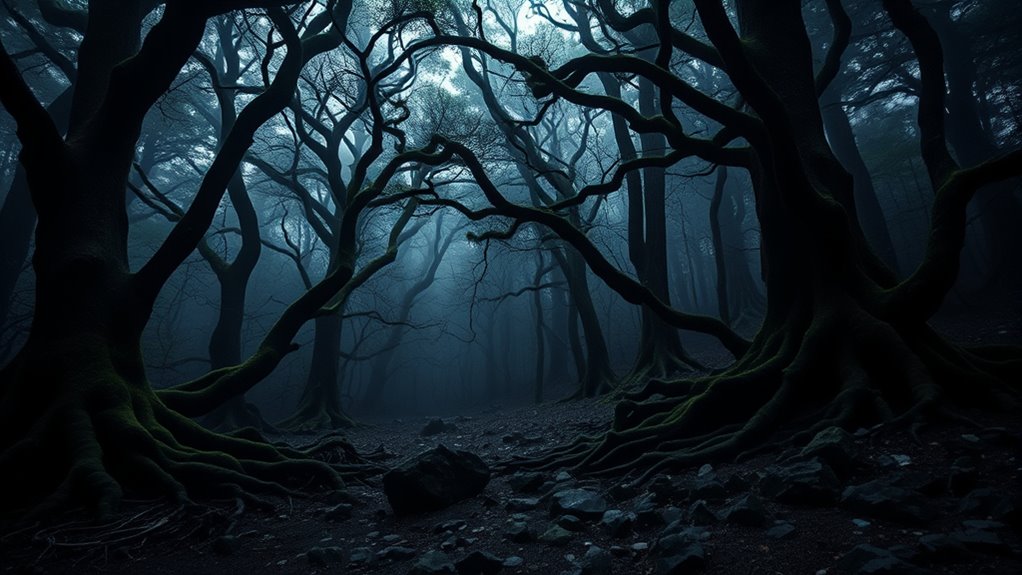
Nestled at the base of Mount Fuji, Aokigahara Forest has a long and mysterious history that dates back centuries. Originally, it was valued for its dense trees and rich soil, which supported local communities. Over time, efforts to preserve the forest became essential for forest conservation, preventing overharvesting and maintaining its ecological balance. Today, you should understand that human activity has shaped its environment, but ongoing conservation efforts aim to minimize environmental impact. The forest’s unique landscape, with volcanic rocks and thick foliage, reflects its geological origins. Recognizing its history helps you appreciate the importance of protecting this natural space, not only for its cultural significance but also to guarantee its ecological stability for future generations. Cultural Heritage plays a vital role in understanding the significance of this area beyond its physical features, especially considering the environmental impact caused by centuries of human interaction. Additionally, ecological preservation is crucial to sustain its diverse flora and fauna for future ecological balance. Furthermore, recent studies have highlighted the importance of local laws and regulations in safeguarding the area from further environmental degradation. Implementing these measures ensures the sustainability of Aokigahara for generations to come.
Legends and Myths Surrounding the Forest
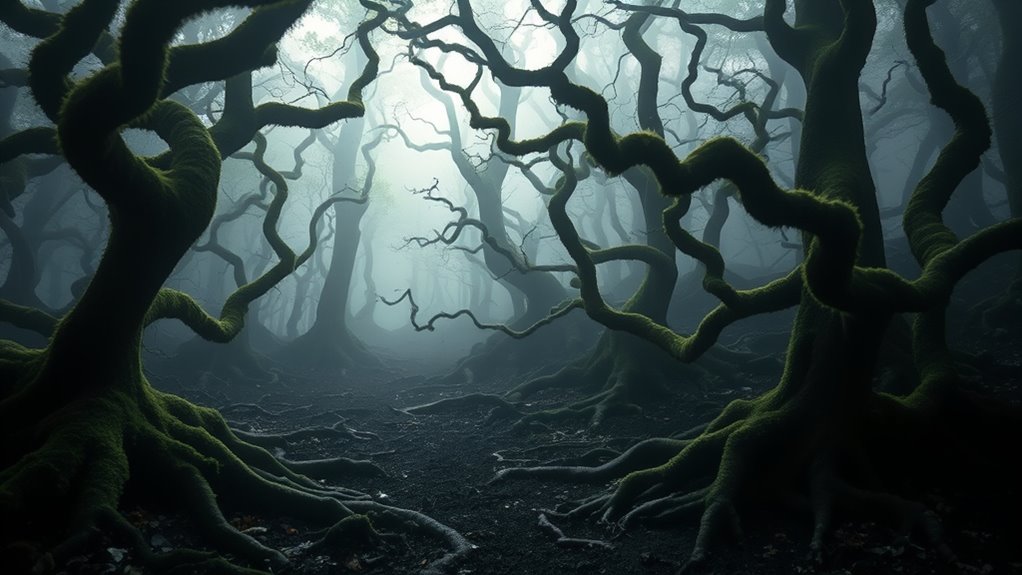
Have you ever wondered why Aokigahara Forest is often called the “Suicide Forest” or why it’s shrouded in so many legends? Local ghost stories and supernatural legends fuel the eerie reputation of the forest. People whisper about spirits that linger among the trees, haunting those who venture too deep. Some say the forest is cursed, with the souls of those who lost their lives there still wandering. Legends tell of ghostly apparitions and mysterious sounds that unsettle visitors. These stories have been passed down through generations, blending fact and myth. The supernatural legends amplify the forest’s dark allure, making it a place where reality blurs with the supernatural, and fear is woven into every shadow and whisper. Additionally, the supernatural legends are often linked to the forest’s unique environment, which creates an atmosphere conducive to such stories. Recent studies highlight how the environmental factors of Aokigahara contribute to its mysterious reputation, fostering an almost otherworldly ambiance that fuels these legends. The dense, tangled woods and the quiet, almost ominous atmosphere further intensify the supernatural tales, as the atmospheric conditions can distort sounds and perceptions, adding to the eerie feeling that permeates the area. These factors can trigger psychological responses in visitors, heightening feelings of unease and reinforcing the supernatural stories.
The Cultural Significance and Perceptions in Japan
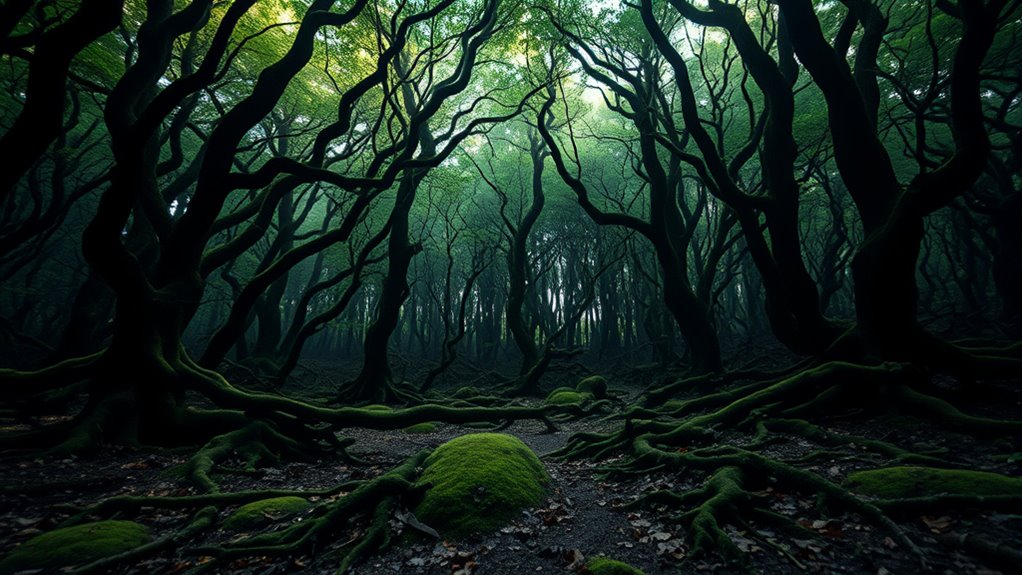
You might notice that Aokigahara holds deep spiritual meaning in Japanese folklore, often linked to spirits and ancestors. Today, many in Japan see the forest as a place to honor tradition, but others view it with caution and respect. Understanding these perceptions helps you appreciate why the forest remains a complex symbol in Japanese culture.
Spiritual Beliefs and Folklore
What role does Aokigahara Forest play in Japan’s spiritual landscape? It’s believed to be a place rich with spiritual symbolism, where the boundary between the living and the dead blurs. Folklore narratives depict the forest as haunted by yūrei, or restless spirits, giving it a haunted reputation rooted in Japan’s spiritual beliefs. Many see it as a sacred site, connecting the physical world to the spiritual domain, where spirits might linger or seek peace. These stories and symbols shape how locals perceive Aokigahara, not just as a forest, but as a place of spiritual significance. The forest’s deep-rooted folklore continues to influence perceptions, embodying the complex relationship between nature, spirituality, and the afterlife in Japanese culture. Additionally, spiritual symbolism associated with the forest reinforces its status as a site where the spiritual and physical worlds intersect. The belief that the forest serves as a spiritual gateway further emphasizes its role as a liminal space that bridges different realms of existence.
Modern Japan’s Perspective
Modern Japan views Aokigahara Forest through a complex lens that blends cultural reverence with contemporary concerns. While some see it as a sacred place rooted in tradition, others recognize it as a site linked to mental health issues and tragedy. Recently, efforts have increased to address the forest’s darker reputation, reflecting Japan’s growing focus on mental health awareness. Modern tourism has also shifted, with visitors approaching Aokigahara more cautiously and respectfully, often seeking to understand its history rather than romanticize its eerie reputation. The government and local communities work to balance respecting cultural significance while promoting responsible tourism. This evolving perspective highlights Japan’s effort to confront societal issues related to mental health, reducing stigma, and fostering a more compassionate understanding of those affected. Additionally, discussions around mental health in Japan are increasingly influenced by cultural perceptions of stigma, encouraging more open conversations and support systems. Recognizing the forest’s natural environment and unique geography has also become part of a respectful approach to its significance. As awareness grows, there is also a greater emphasis on safety measures and providing mental health resources for visitors and locals alike. Furthermore, initiatives aimed at mental health advocacy are helping to reshape the narrative surrounding the forest and mental well-being in Japan.
Cultural Taboos and Respect
Why does Aokigahara Forest hold such deep cultural significance in Japan? It’s a place surrounded by powerful feelings of respect and taboo topics. Many Japanese see the forest as a sacred space, where spirits linger, so visitors are expected to approach with respectful awareness. You should avoid disturbing the environment or engaging in disrespectful behaviors. Locals and authorities emphasize the importance of honoring the forest’s cultural meaning through gestures like silent reflection or quiet observation. Understanding these perceptions helps prevent insensitivity. To show respect, keep these in mind:
- Avoid making loud noises or disrespectful gestures
- Refrain from taking souvenirs or disturbing natural features
- Be discreet if you notice signs related to mental health
- Respect the wishes of those who view the forest as sacred or taboo
The Dark Reality: Suicide Statistics and Prevention Efforts
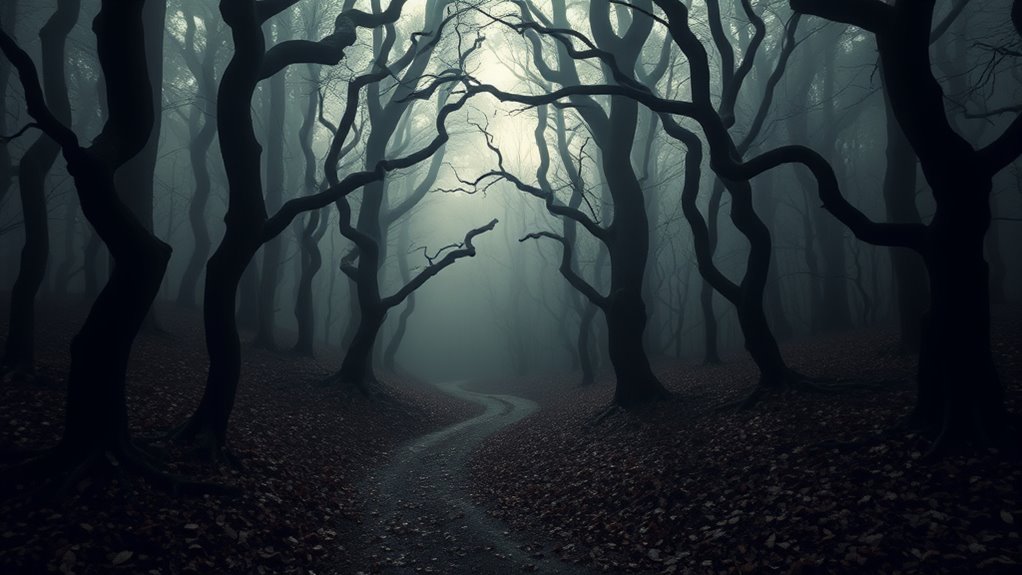
Despite efforts to curb its tragic toll, Aokigahara Forest remains a site of concern due to its high suicide rates. Each year, hundreds of people choose this forest to end their lives, highlighting the urgent need for mental health support. Authorities have increased community outreach programs, aiming to raise awareness and provide help to those struggling with emotional pain. Signs are now posted at the entrance, encouraging individuals to seek help and contact mental health professionals. Local organizations and volunteers work tirelessly to monitor the forest, offering crisis intervention and support services. These prevention efforts are vital, but the underlying issues of mental health stigma and lack of access still pose significant challenges. Combating these factors is essential to reducing the forest’s tragic reputation.
Exploring the Forest: Its Natural Beauty and Tourist Appeal
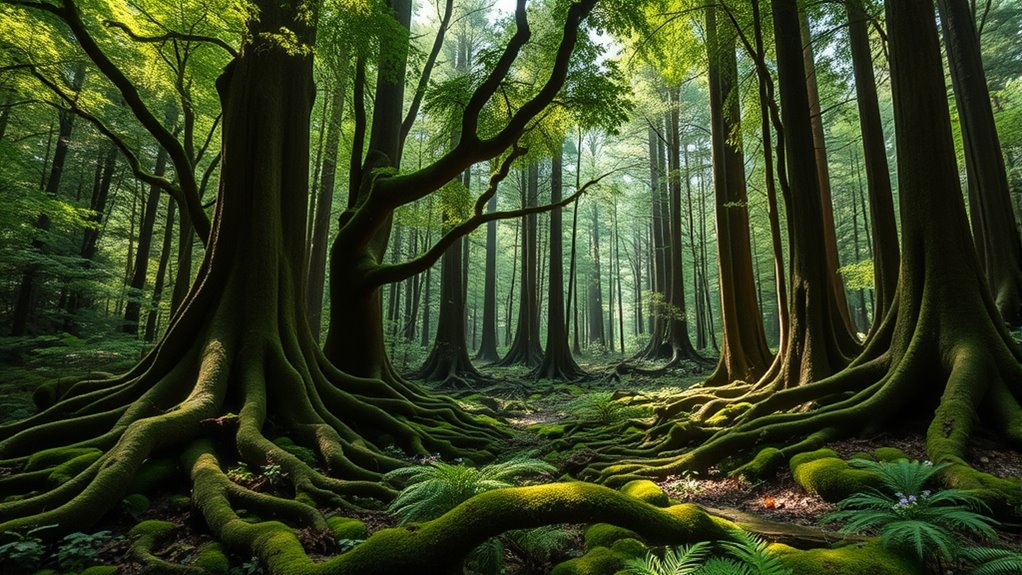
As you explore Aokigahara Forest, you’ll notice its lush, green landscape that changes beautifully with the seasons. The vibrant scenery offers stunning views in spring, summer, autumn, and winter. Whether you’re hiking or simply wandering, the forest’s natural charm makes it a enthralling destination for visitors.
Lush, Verdant Landscape
Aokigahara Forest boasts a stunning tapestry of lush greenery, where dense trees and vibrant mosses create a mesmerizing canopy overhead. As you wander through, you’ll notice the incredible flora diversity, with towering conifers, delicate ferns, and colorful wildflowers thriving in the rich soil. The forest’s vibrant ecosystem offers frequent wildlife encounters, including birds, small mammals, and insects that add to its natural allure. To enhance your experience, consider these highlights:
- Marvel at the thick, moss-covered trees that give the forest its enchanting appearance
- Listen for bird songs echoing through the quiet, leafy corridors
- Spot various insects and small animals camouflaged among the foliage
- Explore the diverse plant life that sustains the forest’s vibrant ecosystem
This lush landscape truly showcases nature’s resilience and beauty.
Seasonal Scenic Changes
Throughout the year, Aokigahara Forest transforms beautifully with each season, offering visitors a dynamic display of natural colors and textures. In spring, vibrant seasonal foliage emerges as fresh green leaves blanket the trees, and the weather variations bring mild temperatures and gentle breezes. Summer turns the forest into a lush, dense canopy, with deeper greens and increased humidity creating a humid, immersive atmosphere. Autumn showcases a stunning palette of fiery reds, oranges, and golds as the foliage changes color, making the forest a breathtaking spectacle. Winter drapes Aokigahara in snow, highlighting stark branches and creating a quiet, serene environment. These seasonal shifts not only enhance the forest’s natural beauty but also reflect the changing weather patterns that influence its landscape year-round.
Hiking and Exploration
Exploring Aokigahara Forest offers visitors a chance to experience its natural beauty firsthand. As you hike its trails, you’ll encounter diverse wildlife encounters, including birds, insects, and small mammals. The forest’s well-maintained paths vary in trail difficulty, so you can choose routes suited to your skill level, from easy strolls to more challenging hikes. Be prepared for the peaceful serenity and lush greenery that make the scenery breathtaking. Keep an eye out for hidden moss-covered rocks and ancient trees that tell stories of the forest’s history. Whether you’re seeking adventure or a quiet escape, the forest’s natural appeal appeals to all explorers. Here’s what to expect:
- Wildlife encounters with native species
- Varying trail difficulty levels
- Scenic viewpoints and quiet spots
- Opportunities for photography and reflection
Ongoing Debates and Ethical Considerations
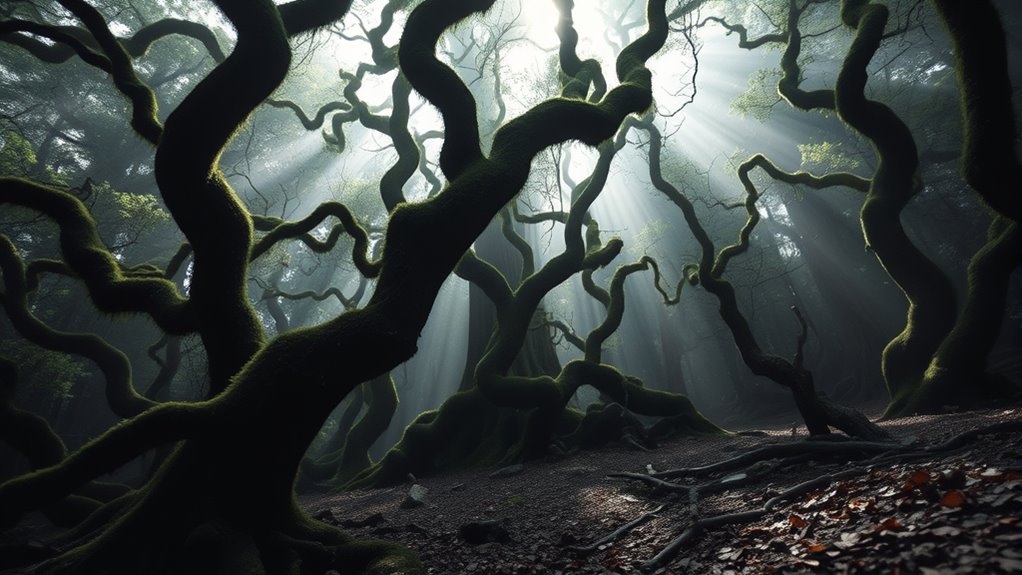
Debates surrounding Aokigahara Forest often center on the ethics of tourism and mental health intervention, raising questions about how society should treat this sensitive site. You face moral dilemmas when balancing respect for those who mourn or seek solace here with the need to prevent harm. Ethical debates emerge over whether increased signage, patrols, or restricted access are appropriate, or if such measures could be seen as invasive or disrespectful. Some argue that intervening might save lives, while others believe it could infringe on personal privacy or romanticize tragedy. As awareness grows, these conversations challenge us to find compassionate, responsible ways to address mental health issues without exploiting or stigmatizing the forest’s somber history.
Frequently Asked Questions
Are There Any Specific Rituals or Customs for Visitors to Aokigahara?
When visiting Aokigahara, you should observe respectful silence and avoid disturbing the atmosphere. Some visitors leave ritual offerings, such as small tokens or flowers, to honor those who have passed. It’s important to approach the forest with sensitivity, respecting its somber purpose. Your behavior should reflect reverence, ensuring that you maintain the quiet and respectful mood, honoring the memory of those who have been affected by its history.
What Measures Are in Place to Prevent Suicides in the Forest?
You’ll find that suicide prevention efforts include frequent patrols by staff and volunteers, who monitor the area for signs of distress. Emergency measures like crisis helplines are clearly posted, and some sections have security cameras to deter risky behavior. These measures aim to intervene quickly, offering help to those in need. Despite this, ongoing awareness campaigns encourage visitors to seek support before considering drastic actions.
How Does Local Japanese Society View Aokigahara Today?
Imagine walking through a quiet village near Aokigahara, where locals now see the forest as a place of reflection rather than despair. Society increasingly promotes mental health awareness, encouraging support instead of stigma. While tourism impacts the area, many view the forest with compassion, understanding it’s a complex issue. You’re likely to find that attitudes are shifting, emphasizing prevention and empathy over fear or judgment.
Have There Been Any Recent Efforts to De-Stigmatize Mental Health in Japan?
You might notice Japan’s recent mental health initiatives aimed at reducing stigma, making it easier for people to seek help. The government and organizations are actively promoting awareness campaigns and providing better mental health services. These efforts focus on stigma reduction, encouraging open conversations about mental health struggles. As a result, there’s a growing acceptance, helping to create a more supportive environment where people feel less ashamed to get help when needed.
Is It Safe for Tourists to Explore the Forest Independently?
Is exploring Aokigahara Forest alone like wandering into the unknown? For your safety, it’s best to join guided tours rather than go solo. They provide essential safety precautions, expert knowledge, and emotional support. The forest’s beauty is mesmerizing, but it’s also important to respect its somber history. With guided tours, you can experience its mystique safely, ensuring your visit remains memorable for all the right reasons.
Conclusion
You might find it surprising that Aokigahara Forest sees around 30 to 50 suicides annually, highlighting its dark reputation. Yet, despite its haunting history, many visit to experience its natural beauty and tranquility. By understanding both its cultural significance and the ongoing efforts to prevent tragedies, you gain a deeper perspective on this complex place. Remember, awareness and compassion are key to addressing the issues tied to Aokigahara’s eerie allure.
